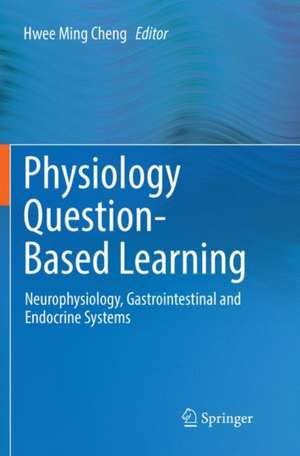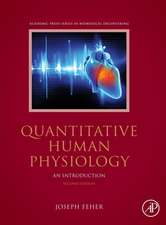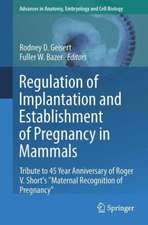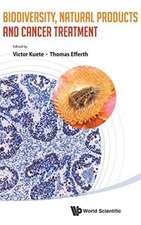Physiology Question-Based Learning: Neurophysiology, Gastrointestinal and Endocrine Systems
Editat de Hwee Ming Chengen Limba Engleză Paperback – 6 iun 2018
This is the second Physiology Question-Based Learning book, written by Prof. Dr. Cheng. He has taught physiology for thirty years. He has pioneered the international physiology quiz, which is now an annual event at the University of Malaya in Kuala Lumpur, Malaysia and at universities around the world. As quiz master, he has designed challenging questions to test concepts and understanding in physiology. This book reflects the style of questions asked during the physiology quiz. The questions are designed to stimulate integrative and homeostatic thinking in physiology.
The Physiology Question-Based Learning books will be helpful to all students of Physiology in medicine, dentistry, pharmacy and allied health sciences. This work is written to make physiology learning engaging and enjoyable and to encourage effective teaching in physiology.
| Toate formatele și edițiile | Preț | Express |
|---|---|---|
| Paperback (2) | 655.49 lei 38-44 zile | |
| Springer International Publishing – 6 oct 2016 | 655.49 lei 38-44 zile | |
| Springer Nature Singapore – 6 iun 2018 | 974.35 lei 38-44 zile | |
| Hardback (2) | 717.00 lei 6-8 săpt. | |
| Springer International Publishing – 4 mar 2015 | 717.00 lei 6-8 săpt. | |
| Springer Nature Singapore – 18 iul 2016 | 983.47 lei 38-44 zile |
Preț: 974.35 lei
Preț vechi: 1025.63 lei
-5% Nou
Puncte Express: 1462
Preț estimativ în valută:
186.50€ • 202.65$ • 156.76£
186.50€ • 202.65$ • 156.76£
Carte tipărită la comandă
Livrare economică 17-23 aprilie
Preluare comenzi: 021 569.72.76
Specificații
ISBN-13: 9789811092749
ISBN-10: 9811092745
Pagini: 229
Ilustrații: XVII, 229 p. 96 illus., 12 illus. in color.
Dimensiuni: 155 x 235 mm
Greutate: 0 kg
Ediția:Softcover reprint of the original 1st ed. 2016
Editura: Springer Nature Singapore
Colecția Springer
Locul publicării:Singapore, Singapore
ISBN-10: 9811092745
Pagini: 229
Ilustrații: XVII, 229 p. 96 illus., 12 illus. in color.
Dimensiuni: 155 x 235 mm
Greutate: 0 kg
Ediția:Softcover reprint of the original 1st ed. 2016
Editura: Springer Nature Singapore
Colecția Springer
Locul publicării:Singapore, Singapore
Cuprins
Part I Neurophysiology
Introduction: Neural Impulses and Homeostatic Balance
Membrane, Local and Action Potentials
Introduction: Hormones and Homeostatic Integration Hypothalamus-Pituitary Hormonal Partners
Thyroid and Parathyroid Glands
Adrenal glands and Pancreas
Male and Female Physiology
Part III Gastrointestinal Physiology
Introduction: You are what you Eat
Motility and Peristalsis
Secretion of Digestive Juices
Digestion of Carbohydrates, Proteins and Fats
Intestinal Absorption
Energy Balance, Metabolism
Part IV Neuro-Endo-Gastrointestinal Physiology
Introduction: Brain-Gut Relationships, Paracrines
Neuro-Endocrinology
Neuro-Gastroenterology
Appendix: Eponyms in Neurophysiology
Bibliography
Introduction: Neural Impulses and Homeostatic Balance
Membrane, Local and Action Potentials
Synapses and Neurotransmission
General Sensations and Nociception
Special Sensations
Muscle and Movements
Part II EndocrinologyGeneral Sensations and Nociception
Special Sensations
Muscle and Movements
Introduction: Hormones and Homeostatic Integration Hypothalamus-Pituitary Hormonal Partners
Thyroid and Parathyroid Glands
Adrenal glands and Pancreas
Male and Female Physiology
Part III Gastrointestinal Physiology
Introduction: You are what you Eat
Motility and Peristalsis
Secretion of Digestive Juices
Digestion of Carbohydrates, Proteins and Fats
Intestinal Absorption
Energy Balance, Metabolism
Part IV Neuro-Endo-Gastrointestinal Physiology
Introduction: Brain-Gut Relationships, Paracrines
Neuro-Endocrinology
Neuro-Gastroenterology
Appendix: Eponyms in Neurophysiology
Bibliography
Textul de pe ultima copertă
This book provides the reader with a range of questions and explanations related to essential aspects of the neural, hormonal and gastrointestinal physiology. The focus of the book is on understanding the homeostatic control in each system by using questions to challenge the reader to think through physiology. In addition, functional integration of the different organ systems is highlighted in an area such as neuroendocrinology and in the study of the neural mechanisms in the gastrointestinal tract.
This is the second Physiology Question-Based Learning book, written by Prof. Dr. Cheng. He has taught physiology for thirty years. He has pioneered the international physiology quiz, which is now an annual event at the University of Malaya in Kuala Lumpur, Malaysia and at universities around the world. As quiz master, he has designed challenging questions to test concepts and understanding in physiology. This book reflects the style of questions asked during the physiology quiz. The questions are designed to stimulate integrative and homeostatic thinking in physiology.
The Physiology Question-Based Learning books will be helpful to all students of Physiology in medicine, dentistry, pharmacy and allied health sciences. This work is written to make physiology learning engaging and enjoyable and to encourage effective teaching in physiology.
This is the second Physiology Question-Based Learning book, written by Prof. Dr. Cheng. He has taught physiology for thirty years. He has pioneered the international physiology quiz, which is now an annual event at the University of Malaya in Kuala Lumpur, Malaysia and at universities around the world. As quiz master, he has designed challenging questions to test concepts and understanding in physiology. This book reflects the style of questions asked during the physiology quiz. The questions are designed to stimulate integrative and homeostatic thinking in physiology.
The Physiology Question-Based Learning books will be helpful to all students of Physiology in medicine, dentistry, pharmacy and allied health sciences. This work is written to make physiology learning engaging and enjoyable and to encourage effective teaching in physiology.
Caracteristici
Emphasis on homeostasis in physiological systems
Provides an overview of selected questions from the concepts tested in the
International Physiology Quiz
Uses simple summary diagrams to illustrate essential concepts
Provides an overview of selected questions from the concepts tested in the
International Physiology Quiz
Uses simple summary diagrams to illustrate essential concepts















